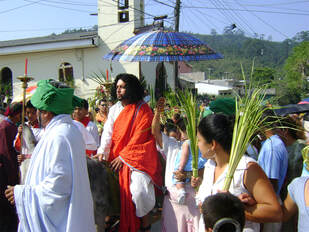|
Lenten Bible Blog, 6th Sunday of Lent (Palm Sunday) (Psalm 118:1-2, 19-29; Mark 11:1-11 or John 12:12-16)  Palm Sunday Procession, from Art in the Christian Tradition, a project of the Vanderbilt Divinity Library, Nashville, TN. http://diglib.library.vanderbilt.edu/act-imagelink.pl?RC=54312. Original source: http://www.flickr.com/photos/johndonaghy/3415402416/. Palm Sunday Procession, from Art in the Christian Tradition, a project of the Vanderbilt Divinity Library, Nashville, TN. http://diglib.library.vanderbilt.edu/act-imagelink.pl?RC=54312. Original source: http://www.flickr.com/photos/johndonaghy/3415402416/. Ps 118 stems from someone worshiping at the temple. The white spaces between many verses (e.g., between vv. 20 and 21 or between vv. 25 and 26) indicate that one or another element of the liturgy has been preserved in this psalm. For example, vv. 1-4 provide both liturgical instructions and a refrain. And there are references to movement into the temple, vv. 19-20 and 26-27. The Hebrew word in 118:1, which is translated as “steadfast love,” can also be translated “covenant loyalty,” (e.g., Deut 7:9). Read this way, the psalm participates in Israel’s covenantal traditions, which have been a hallmark in lections during this Lenten season. Christians have understood the psalm in creative ways. They construe “This is the day that the Lord has made” (v. 24) as a reference to Sunday, and even more to Easter. They view “the stone that the builders have rejected” (v. 22) as a reference to Jesus’ rejection (Mk 12:10). They claim that the statement “This is the Lord’s doing” (v, 23) refers to Jesus’ passion (Mk 12:11). A prayer for help, “Save us!” (v. 25), appears as “Hosanna!” in Mk 11:9. “Blessed is the one who comes in the name of the Lord” (v. 26) is cited in Mk 11:9 as a reference to Jesus. In sum, Psalm 118 became an important way for expressing early Christian understandings of Jesus’ life, death, and resurrection. The alternate NT lections offer Marcan and Johannine accounts of Jesus’ entry into Jerusalem. They pick up on the idea of “a festal procession with branches” in our Psalm (v. 27). And they build on Old Testament royal traditions. Noteworthy is Jesus riding on a colt, which likely refers to a procession in which a king rides on “a colt, the foal of a donkey” (Zech 9:9). This king is both “triumphant and victorious” and “humble,” qualities that early Christians attributed to Jesus. The procession also included spreading cloaks on the ground before a king, a practice attested in 2 Kgs 13. And the presence of leafy branches as a part of a victorious procession is present in 1 Macc 13:51. Moreover, the specific reference to palm branches, present only in John 12:13, is also part of such processions, so 2 Macc 10:7. These royal allusions were made specific when the crowd that gathered around Jesus spoke about “the coming kingdom of our ancestor David” (Mk 11:10) and said about him, “the King of Israel” (John 12:13). It is no wonder that the Romans viewed this procession as an act of sedition. Strikingly, “the disciples did not understand these things.” (John 12:16). The crowd clearly thought that Jesus was the anticipated king, whereas the disciples did not yet know the full significance of what was about to happen.
0 Comments
Your comment will be posted after it is approved.
Leave a Reply. |
Details
AuthorDavid Petersen is Franklin N. Parker Professor Emeritus of Old Testament, Emory University. While at Emory, he was also Academic Dean at the Candler School of Theology, where he received the Emory Williams Distinguished Teaching Award. Archives
April 2021
Categories
All
|

 RSS Feed
RSS Feed